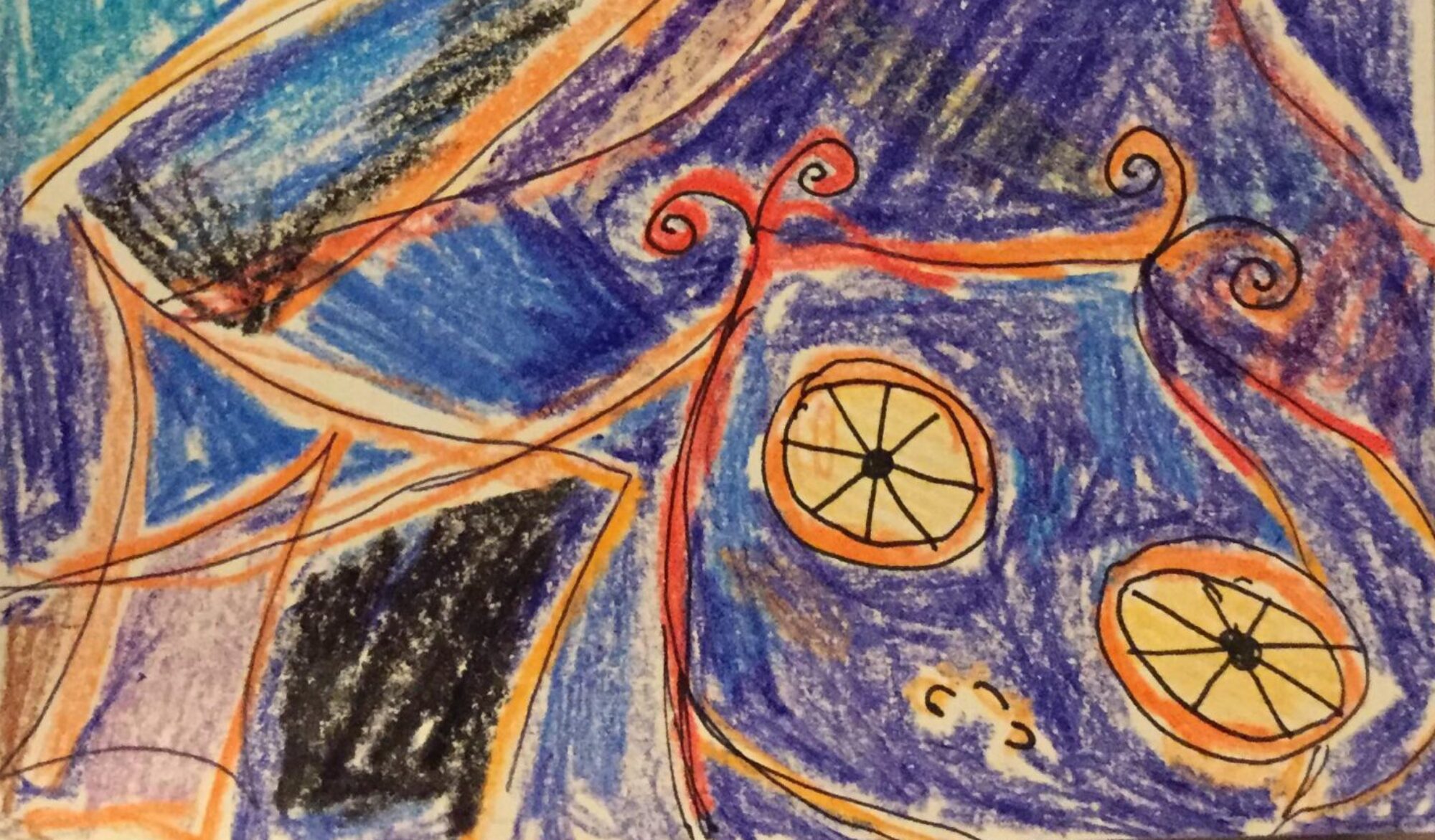Conceptual starting point
Space and time are concepts that end up finding their way into most of my work. For this project, I initially considered mapping out the view I see from my window, recording the sounds that emerge and fade, the way the light moves over the space, the smells that enter and fade from the scenery… However, after a talk with Linda O’Keefe, it occurred to me that I was way more interested in creating an imaginary space or more guiding a listener through an imagined landscape.
Around a year ago, I began to understand the meaning of meditation. I’d listened to guided meditations in the past, and as an imaginative child, I loved any activity that would allow me to dream and travel through my mind. I remember my mom got me a mermaid sleep meditation CD, and I loved falling asleep imagining myself swimming in waves of light. Now, I still love visualizing in meditation – it allows for deep relaxation and sometimes connection and conversation with more subconscious part of our selves.
For this project, I am thinking of creating guided, audio meditations that incorporate sound in order to bring the listener into a certain space. Like with most of projects this semester, I will continue exploring the city from the safety of my room, reporting imaginative stories based on memory and emotion.
Primary research
I had initially planned to create a trio of soundscape meditations, in which I blurred the lines between an urban and imaginary space. I don’t mean just by referencing or describing the urban environment, but by acknowledging that the city is imagined and merged with the memories of those that inhabit it. Even the specific city places I want to reference are in many ways imaginary, being that each person constructs an image of their physical space in their minds, filtering sensory information through emotion and past experience.

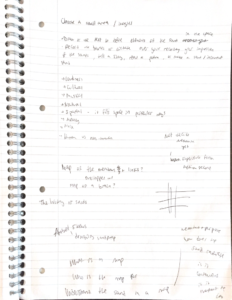
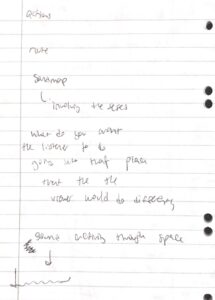
Sketchbook notes about sound, Blades, 2021
I started this project by simply recording sounds on my phone that I found particularly interesting. This could be sitting in my room with the window open hearing cars rush by, being on the bus, walking next to the Portobello shoreline, or the sound of a stream running over rocks in the Pentlands. I listened to all the audio recordings I’ve ever made on my phone, and interestingly found a lot of songs or bits of songs I’ve written over the years, and a few soundscapes I’d found interesting.
Audio recordings
I layered one of those melodies with a few other city noises, just as an experiment. I then started playing around with effects, adding an echo effect and also reverb to make it sound like the singing was coming from a cave. The base layer of the meditation is what I call ‘accidental music’. Accidental music can be the sounds of birds chirping in perfect harmony, the echo of someone laughing in the distance, the sound of a car rushing by or even actual music that someone is playing that I happened to capture via recording on my phone. The point of this meditation is for one to react creatively to the sounds they are presented with – the idea is for the listener to map their emotional reaction to the layered auditory stimuli. For this reason, it should be listened to with headphones and at a consistent volume level throughout the whole track.
I have also created instructions one should read before beginning the listening project, inspired by Pauline Oliver’s deep listening exercises. I wanted the wording of the questions to help immerse the listener in the world of the soundscape before entering it, guiding their journey, acting as a sort of map, inspired by my own interior imaginary map.
‘Surrender to the crumble’ audio track
This audio is meant to be listened to in the morning to guide the listener through a blending of my personal current reality with an imaginary space that spans across the ocean to my hometown, Sintra. The track fades in at the beginning and you can hear someone playing guitar on Bruntsfield links. I recorded this while sitting on the links with a friend, Alicja, and her dog, which I was also trying to record sounds of. You can hear me go ‘aw’, which was a common reaction I had while marveling at her dog. Right after, you can hear Alicja say ‘oh, you’re gorgeous’ to her dog. When added the echo effect, I love the way these accidentally captured phrases sort of become a reminder to the listener. With the fade-in effect, plus making it so that the track starts only in the right ear, I tried to make it mimic the effect of me opening my window in the morning (which is on the right side of my bed) and hearing someone playing music on the Links. Then, I get up and look at the mirror, and hear the echoes ‘you’re gorgeous. The listener is meant to do the same. The music, mixed with the sounds of birds chirping which I added later and the phrases create a dreamy, sunny space in the mind of the listener.
The break in the track comes when I say ‘can I get some sounds of… I don’t know, slobbering’ at 0:40, which was directed towards the dog. I layered this with the sound of a bus, which is meant to emulate the feeling of leaving this soft, comfortable self-loving space of the first part of the track. The sound of the bus then leads into the song ‘Surrender to the crumble’, which I recorded on my phone around a year ago. I used the original recording and added the echo effect and also reverb, to make it sound like the singing is coming from a large, wet cave. The bus sound, along with the sounds of a busy lunchtime at an elderly home, serve as a gritty reminder of the urban landscape. I like that this is contrasted with my young voice, reminding the listener to ‘surrender to the crumble’ of movement and of the passing of time. The sounds become louder, the listener is forced to sit through this. This is the ultimate blending of my memory of working at this elderly home, the bus as if transporting me back to that moment, and I am reminding myself to give into the passing of moments. This then fades into just my voice, with some birds chirping at the end, which feels like leaving a dark cave and walking into the sunlight, having surrendered into the crumble.
In my work, I like to include imperfections. When photographing the dollhouse for the ‘Making and Breaking Narrative’ project, I purposefully didn’t clean the dust that had settled in the corners of the rooms, because I felt like it had a part to play in the story I was telling. Similarly, I left in the sound of me coughing at 1:19. The way it echoes and slices through the wateriness of the ‘surrender to the crumble’ sounded really cool to me, and I thought it would be interesting to see how someone who is painting to this audio might interpret the sharpness of the coughs.
I created a series of drawings and a painting in reaction to meditation 1. The painting on cardboard includes bits of dirt and dust gathered from the floor which were stuck on when the paint was still wet. This is to show that the listener does not have to be a practicing artist to react to the audio; all it takes is a willingness to listen and to truly surrender to the crumble.
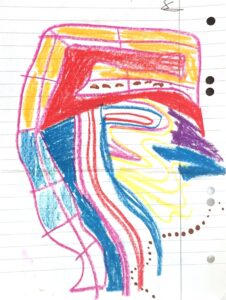


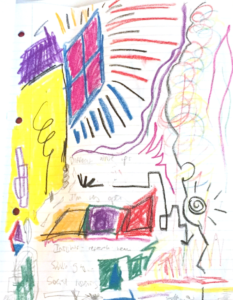
‘surrender to the crumble’ sketches, crayon on paper, Blades, 2021
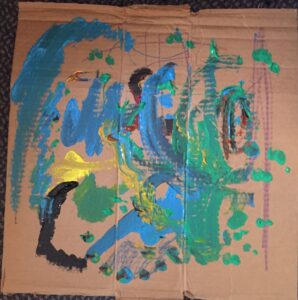

‘surrender to the crumble’, acrylic paint and dirt on cardboard, Blades, 2021
Painting video:
https://drive.google.com/file/d/14ADkpnL4xE1US1C09ze8188I89uPjyRp/view?usp=sharing
The second meditation involves listening to a playlist, while the person goes about their day, and to notice how it interacts with the sounds surrounding their own environment. The criterion for song choice was simply how much they made me travel in my own mind, and because most of the songs involve layering different sounds, it helped me fine tune my hearing and listen deeply to my own surroundings, especially in moments of silence within a song. The listener is invited to go about their everyday life, or to do anything they would do in silence between the morning and the afternoon, whether that be taking a bath, working out, reading, answering emails, meditating, yoga, cooking, eating, sleeping…
‘The silence between the morning and the afternoon’, a playlist by Abigail Blades, 2021
I created these poems and drawings in reaction to meditation 2:
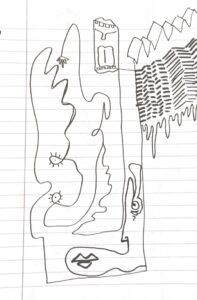
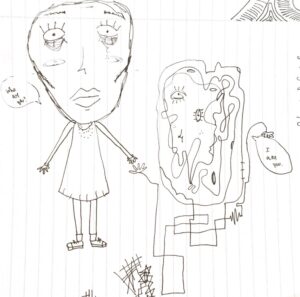
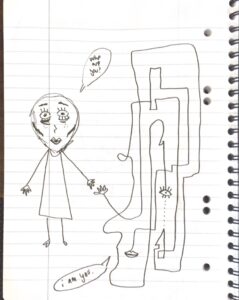

‘i am you’ sketches, pen on paper, Blades, 2021
Secondary research
I explored Pauline Oliveiras deep listening techniques and exercises, which heavily inspired the way I want my listening exercises to be understood:
‘These exercises are intended to calm the mind and bring awareness to the body and its energy circulation, and to promote the appropriate attitude for extending receptivity to the entire space/time continuum of sound. This kind of receptivity is essential for creative activity in the arts and can be applicable to any discipline.’
‘Repetition of an exercise invites the possibility of new understanding and the development of listening as a desirable practice or tool for living, learning and creative work.’
Here is an example of a deep listening exercise which is similar to the one I created. Oliveros focuses a lot of the listening process on the body, and in describing in depth what each body part should be doing, whereas I wanted my exercises to transport the listener into a new imaginary plane, all mental travelling, distinct from the body. Nonetheless, our exercises overlap because they ask the listener to become the observer, first in their minds, and then in the material world. Similarly, I ask the listener to introspect before and throughout the exercises.
‘Sit either on the floor or in a chair. If on the floor, use a cushion to raise the sitz bones. If sitting in a chair, feet are flat on the floor. The legs should be crossed either in full lotus position, 48 or tucked in close to the body with the knees relaxed downward to the floor. Posture is relaxed upper body, chin tucked in slightly, balanced on the ‘sitz‘ bones and knees. Palms rest on the thighs, or palms folded close to the belly. Eyes are relaxed with the lids half or fully closed. At the sound of a bell or gong listen inclusively for the interplay of sounds in the whole space/time continuum. Include the sounds of your own thoughts. Can you imagine that you are the center of the whole? Use this mantra 49 to aid your listening: With each breath I return to the whole of the space/time continuum. If a sound takes your attention to a focus, then follow the sound all the way to the end as you return to the whole of the space/time continuum. At the sound of the bell prepare to review your experience and describe it in your journal.’
I was inspired by Carlo Carrá’s futurist manifesto, which outlines the principles of the Futurism art movement, which was against Impressionism and all of its solemnness and silence. The futurists placed sound, noise and smell at the centre of their art: they wanted bright colour, reckless experimentation, ‘imagination without strings’, which is inspired my audio track and subsequent response.
‘We Futurists therefore claim that in bringing the elements of sound, noise and smell to painting we are opening fresh paths. We have already taught artists to love our essentially dynamic modern life with its sounds, noises and smells, thereby destroying the stupid passion for values which are solemn, academic, serene, hieratic and mummified: everything purely intellectual, in fact. Imagination without strings, words-in-freedom, the systematic use of onomatopoeia, antigraceful music without rhythmic quadrature, and the art of noises —these were created by the same Futurist sensibility that has given birth to the painting of sounds, noises and smells.’
The instrumental song ‘in god’s childlike hands’ also inspired the meditations. It features such an interesting layering of sounds that almost sounds like it’s coming from an organ in a church. The song builds in a really playful and light way, adding new dimensions to the narrative. The playfulness of the notes is heavy, but my favorite part is at 02:10 when you can clearly hear the ambulance sounds that have been building faintly in the background throughout the song. Its like an expected emergency, but the song becomes louder, the repetition of melody more intense, the ambulance ringing all pervasive. The listener isn’t sure whether the sounds are coming from the song or from their own surroundings. It transports the listener into the middle of some spiritual crime-scene, the lines between reality and imagination become increasingly blurred until it suddenly… stops.
Podhasjsky is a contemporary visual artist whose work interweaves naturally occurring systems and landscapes with graphic and technological elements in a really poignant way. He’s often inspired by sound and sound waves in creating images that perfectly mimic the melting of nature. This piece inspired me in particular because it made use of the same sort of color palette I had used for my ‘surrender to the crumble’ painting.
Podhajsky’s work has been described as “striking abstractions of nature – mirrored vistas, engulfing waves, rippling, melting cosmic landscapes”
https://www.instagram.com/p/CHF91Uig-KB/
Another really good listening exercise, in which words become frequencies echoing in a room:
